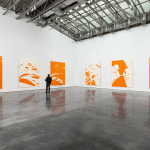Clever ideas–once confined to the brainstorming sessions of Mad Men and corporate art directors– have become the backbone of contemporary art practice, especially among recent MFA grads. These emerging artists are perfectly happy to create pieces to suit specific curatorially-prescribed concepts and spaces. Against this cultural backdrop, an exhibition like “Double Lives” at the New Britain Museum of American Art feels a little old-fashioned. But perhaps for that very reason, it is all the more fascinating and refreshing. Guest curator Richard Boyle’s conceit is that historically, illustration stands in relation to fine art as prose does to poetry.
“In the nineteenth century, the academy looked down its nose at assigned work,” says Douglas Hyland, NBMAA director. “Free choice was taken away when you had a book or magazine editor telling you what they wanted from you.” Hartford Advocate art critic Alan Bisbort writes that many artists didn’t sign their illustration work, or they used pseudonyms. Many artists/illustrators in the exhibition–Elihu Vedder, Henry Farny, John La Farge, Ellen Emmett Rand, Ben Sloweny and others– are more obscure than their contemporaries who focused on “fine art,” like Winslow Homer, Rockwell Kent and Childe Hassam.
According to the exhibition’s press release, illustration itself has “many functions, but the exhibition emphasizes illustrated books, magazine articles and stories, non-fiction and fiction, directed at an audience of adults, as well as children and young people. Illustrations were based on a given text, with the goal of illuminating that text. Fine art, however, is created according to the artists� own creativity and inspiration.”
“Double Lives: American Painters as Illustrators, 1850-1950,” organized by Richard Boyle. New Britain Museum of American Art, New Britain, CT. Through Feb. 22.
Related post:
Roberta Smith’s advice to young artists: Learn to paint
Playing for Fung in Santa Fe























Yes. It is the era of the curator as art star. So many exhibits focus on curatorial vision, leaving the artist’s vision by the wayside. It’s no wonder recent grads are so accommodating.
“Illustrations were based on a given text, with the goal of illuminating that text. Fine art, however, is created according to the artists� own creativity and inspiration.”
What about Michelangelo’s biblical ‘illustrations’ for the Sistine Chapel? or William Blake’s ‘illustrations’ for his own poetry and that of Dante or Gray?
What is disparaged by critics or academy is not illustrating a text – but the very straight-forward or pedestrian interpretation of the text, or indeed choice of text, and the equally bland style of picture. To illustrate for artists – even when there is no ostensible text – is generally understood as the merely flat-footed or glib depiction, rather than depiction itself.